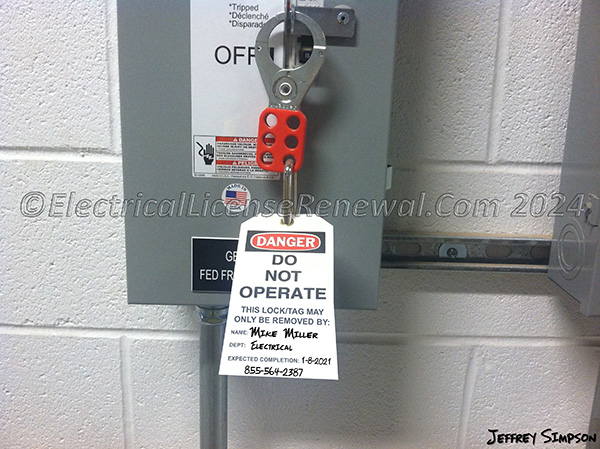NFPA 70E 120.2 Lockout/Tagout Program & Responsibilities.

It is the responsibility of the employer to establish, implement, and document a lockout/tagout (LOTO) program to safeguard workers from exposure to electrical hazards. The lockout/tagout program must specify all required lockout/tagout procedures and practices.
The lockout/tagout program is a critical safety measure mandated in many workplace environments, especially those involving electrical and mechanical equipment. It's designed to prevent the accidental startup of machinery or equipment or the release of hazardous energy during maintenance and servicing activities. Here’s a more detailed look at the employer's responsibilities regarding the lockout/tagout program:
Employer Responsibilities
- Establish the Program: The employer must develop and implement a lockout/tagout program tailored to the specific needs of their workplace. This program should address all machinery and equipment capable of being locked out and should be comprehensive enough to cover all types of maintenance and service work.
- Document the Program: The program must be formally documented. This documentation serves as a reference for all employees and must be accessible to them. It should clearly outline the scope, purpose, authorization, rules, and techniques to control hazardous energy, as well as the means to enforce compliance.
- Specify Procedures and Practices: The documentation must include detailed procedures for shutting down, isolating, blocking, and securing machinery to control hazardous energies such as electrical, mechanical, hydraulic, pneumatic, chemical, and thermal. It should also specify the methods for the placement, removal, and transfer of lockout/tagout devices and who may perform these tasks.
It is the responsibility of the employee to follow the lockout/tagout policy and all other safety procedures set forth by the employer.
The lockout/tagout (LOTO) policy is a crucial safety protocol designed to protect employees from the hazards associated with the unexpected energization or release of stored energy in machines and equipment during maintenance and repair activities. While employers are responsible for establishing and enforcing these policies, employees also have specific responsibilities under these programs:
Employee Responsibilities
- Following Procedures: It is the primary responsibility of the employee to follow the lockout/tagout procedures exactly as specified in the training and policy documents provided by the employer. This includes ensuring that all steps of the lockout/tagout sequence are followed without shortcuts, from the initial shutdown to the placement of lockout devices and the verification of zero energy state.
- Using Devices Correctly: Employees must correctly use the designated lockout/tagout devices as trained. This means using only the locks and tags provided by the employer and applying them in the manner instructed, ensuring that the equipment is effectively isolated from its power source.
- Communication: Employees need to communicate effectively with their colleagues about the status of lockout/tagout procedures. This includes informing affected individuals when lockout/tagout devices are applied and removed.
- Attending Training: Employees are required to participate in all training sessions related to lockout/tagout and other relevant safety procedures. Continuous education on safety practices is vital as it ensures that all team members are up to date with the latest safety standards and procedures.
- Reporting Issues: Employees should report any observed issues with the lockout/tagout procedures or any other safety measures to their supervisors immediately. This could include defective equipment, missing lockout devices, or any deviation from the established safety procedures.
Below is a sample of NFPA 70E. For the complete section, see the actual NFPA 70E text at NFPA.ORG. Once there, click on the free access link to NFPA 70E.
120.2 Lockout/Tagout Program.
(A) General. Each employer shall establish, document, and implement a lockout/tagout program. The lockout/tagout program shall specify lockout/tagout procedures to safeguard workers from exposure to electrical hazards. The lockout/ tagout program and procedures shall also incorporate the following:
(1) Be applicable to the experience and training of the workers and conditions in the workplace
(2) Meet the requirements of 120.2 through 120.6
(3) Apply to fixed, permanently installed equipment, temporarily installed equipment, and portable equipment
(B) Employer Responsibilities. The employer shall be responsible for the following:
(1) Providing the equipment necessary to execute lockout/ tagout procedures
(2) Providing lockout/tagout training to workers in accordance with 110.6(B)
(3) Auditing the lockout/tagout program in accordance with 110.5(M)(3)
(4) Auditing execution of the lockout/tagout procedures in accordance with 110.5(M)(3)